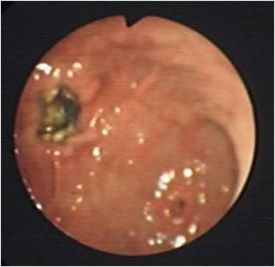Difference between revisions of "Gastritis, Acute"
Sealpoint33 (talk | contribs) |
|||
| Line 61: | Line 61: | ||
==References== | ==References== | ||
<References/> | <References/> | ||
| + | [[Category:Stomach_and_Abomasum_-_Inflammatory_Pathology]][[Category:To_Do_-_Clinical]] | ||
Revision as of 11:50, 28 June 2010
| This article has been peer reviewed but is awaiting expert review. If you would like to help with this, please see more information about expert reviewing. |
Signalment
- Dogs are more commonly affected than cats due to their less selective eating habits.
Description
Acute inflammation of the stomach is not uncommon, especially that of the canine. The cause is usually the ingestion of substances such as:
- foreign objects
- spoiled or contaminated food
- toxic plants
- chemicals
- drugs (especially non-steroidal anti-inflammatory drugs)
Infectious, viral and bacterial causes are thought to exist in cats and dogs but have not been identified as of yet.
Ingestion of these substances causes the disruption of the gastric mucosal barrier. This results in increased permeability, with hydrogen ions and pepsin penetrating the mucosa. An inflammatory response subsequently occurs that may damage blood vessels, resulting in the extravasation of blood and plasma into the gastric lumen. Mucosal erosions can develop due to necrosis of the mucosal epithelial cells.
Gastritis can cause contraction of gastric smooth muscle which causes spasms and pain. Vomiting may result from the stimulation of nerve endings that connect with the vomiting centre[1].
Diagnosis
Acute gastritis is a diagnosis of exclusion based on physical examination findings, history of ingestion of causative substances and diagnostic tests.
Clinical Signs
- acute vomiting (food, bile together with small amounts of blood may be present in the vomitus)
- anorexia
- polydipsia
- lethargy
- depression
- dehydration if severely affected
Abdominal Palpation
Severely affected animals may show signs of discomfort on palpation of the cranial abdomen.
Laboratory Tests
Clinical pathology such as haematology and biochemistry can be used to rule out conditions such as uraemia, diabetic ketoacidosis, hypoadrenocorticism, hepatic disease, hypercalcaemia and pancreatitis.
Radiography
Abdominal radiographs may be taken if the animal is severely ill and to rule out other causes such as an alimentary foreign body or obstruction.
Endoscopy
Gastroscopy may be used to visualise gastric erosions/ulcers and hyperaemia.
Treatment
Many different techniques of treating acute gastritis have been described in the literature. In general, therapy is designed to rest the stomach by witholding food and maintaining the animal's fluid , electrolyte and acid/base balance.
- Parenteral fluid therapy.
- Witholding food and water for 24hours is usually sufficient to control vomiting.
- Small amounts of a bland diet such as boiled chicken and potato can be offered once the animal has not vomited for at least 12 hours.
- Gut protectants should be considered if the animal presents with haematemesis. Some examples include:
- Sucralfate - Forms a protective barrier over the mucosal surface and also stimulates bicarbonate and mucus secretion.
- Omeprazole - A proton pump inhibitor that reduces gastric acid secretion.
- Anti-emetics should only be used when vomiting is debilitating and are resulting in pain and unsustainable fluid and electrolyte losses[2].
Prognosis
The prognosis is excellent if fluid and electrolyte balance is maintained.
